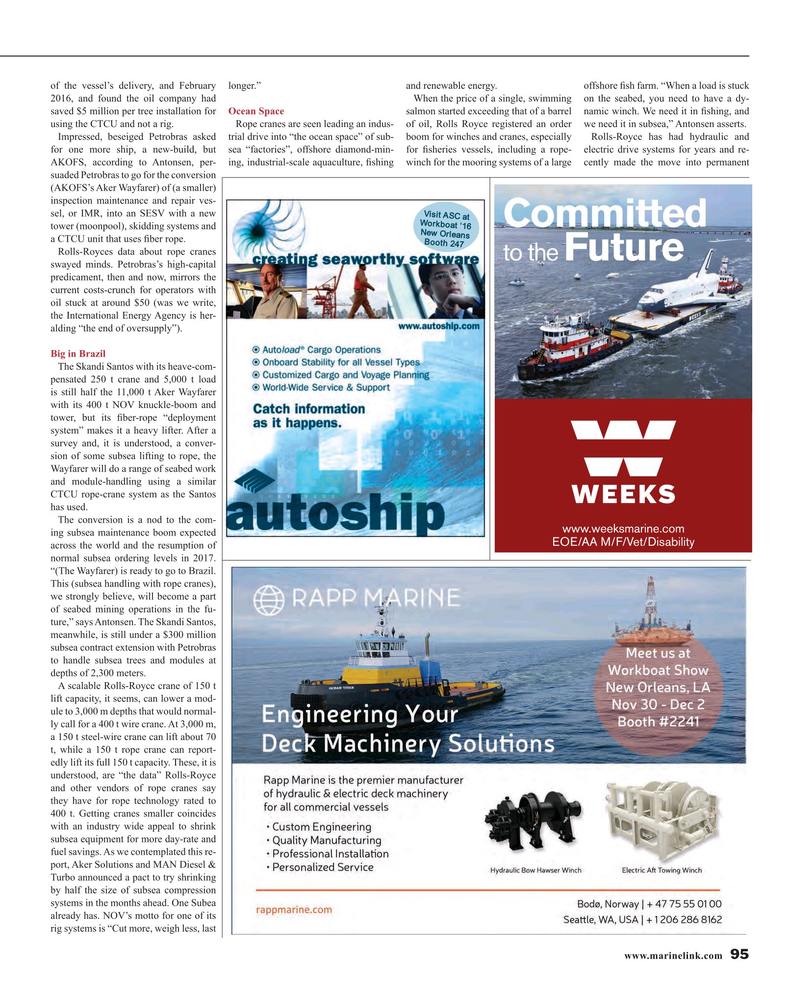
Page 95: of Maritime Reporter Magazine (November 2016)
Workboat Edition
Read this page in Pdf, Flash or Html5 edition of November 2016 Maritime Reporter Magazine
of the vessel’s delivery, and February longer.” and renewable energy. offshore ? sh farm. “When a load is stuck 2016, and found the oil company had When the price of a single, swimming on the seabed, you need to have a dy- saved $5 million per tree installation for Ocean Space salmon started exceeding that of a barrel namic winch. We need it in ? shing, and using the CTCU and not a rig. Rope cranes are seen leading an indus- of oil, Rolls Royce registered an order we need it in subsea,” Antonsen asserts.
Impressed, beseiged Petrobras asked trial drive into “the ocean space” of sub- boom for winches and cranes, especially Rolls-Royce has had hydraulic and for one more ship, a new-build, but sea “factories”, offshore diamond-min- for ? sheries vessels, including a rope- electric drive systems for years and re-
AKOFS, according to Antonsen, per- ing, industrial-scale aquaculture, ? shing winch for the mooring systems of a large cently made the move into permanent suaded Petrobras to go for the conversion (AKOFS’s Aker Wayfarer) of (a smaller) inspection maintenance and repair ves-
Visit ASC at sel, or IMR, into an SESV with a new
Workboat ‘16
Committed tower (moonpool), skidding systems and
New Orleans a CTCU unit that uses ? ber rope.
Booth 247
Rolls-Royces data about rope cranes to the Future swayed minds. Petrobras’s high-capital predicament, then and now, mirrors the current costs-crunch for operators with oil stuck at around $50 (was we write, the International Energy Agency is her- alding “the end of oversupply”).
Big in Brazil
The Skandi Santos with its heave-com- pensated 250 t crane and 5,000 t load is still half the 11,000 t Aker Wayfarer with its 400 t NOV knuckle-boom and tower, but its ? ber-rope “deployment system” makes it a heavy lifter. After a survey and, it is understood, a conver- sion of some subsea lifting to rope, the
Wayfarer will do a range of seabed work and module-handling using a similar
CTCU rope-crane system as the Santos has used.
The conversion is a nod to the com- www.weeksmarine.com ing subsea maintenance boom expected
EOE/AA M/F/Vet/Disability across the world and the resumption of normal subsea ordering levels in 2017. “(The Wayfarer) is ready to go to Brazil.
This (subsea handling with rope cranes), we strongly believe, will become a part of seabed mining operations in the fu- ture,” says Antonsen. The Skandi Santos, meanwhile, is still under a $300 million subsea contract extension with Petrobras to handle subsea trees and modules at depths of 2,300 meters.
A scalable Rolls-Royce crane of 150 t lift capacity, it seems, can lower a mod- ule to 3,000 m depths that would normal- ly call for a 400 t wire crane. At 3,000 m, a 150 t steel-wire crane can lift about 70 t, while a 150 t rope crane can report- edly lift its full 150 t capacity. These, it is understood, are “the data” Rolls-Royce and other vendors of rope cranes say they have for rope technology rated to 400 t. Getting cranes smaller coincides with an industry wide appeal to shrink subsea equipment for more day-rate and fuel savings. As we contemplated this re- port, Aker Solutions and MAN Diesel &
Turbo announced a pact to try shrinking by half the size of subsea compression systems in the months ahead. One Subea already has. NOV’s motto for one of its rig systems is “Cut more, weigh less, last www.marinelink.com 95
MR #11 (90-97).indd 95 11/5/2016 11:48:38 PM

 94
94

 96
96
